Key takeaways:
- Understanding the underlying motivations behind difficult behaviors can transform interactions and create a more inclusive environment.
- Effective management of participants, including setting clear guidelines and fostering a respectful dialogue, is crucial for successful events.
- Utilizing strategies such as active listening, open-ended questions, and humor can help engage difficult attendees and promote collaboration.
- Establishing clear communication channels and fostering pre-event relationships can significantly enhance participant engagement and satisfaction.
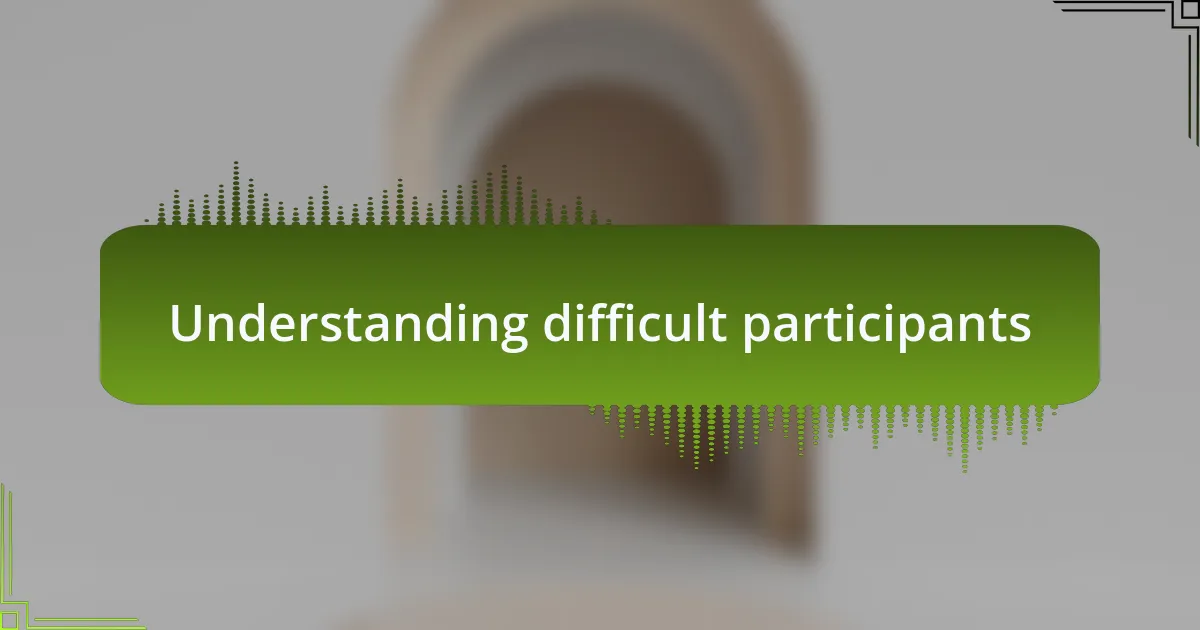
Understanding difficult participants
When I think about difficult participants, I remember a specific moment at an expo where tensions ran high. I encountered a participant who was openly critical of a session, raising his voice and challenging the speaker. In that instant, I realized that beneath his frustration lay unmet expectations. How often do we overlook the deeper feelings behind challenging behaviors?
Understanding the motivations behind difficult behaviors is crucial. For instance, I once had a participant who consistently interrupted others, and my initial reaction was frustration. After striking up a side conversation, however, I discovered that she felt unheard and was desperate to share her insights. This experience taught me that often, people’s behavior stems from a desire for connection rather than a desire to disrupt.
It’s also important to consider the context in which these behaviors emerge. During a recent workshop, I noticed that a participant, known for being disengaged, suddenly became hostile when discussing a topic he was passionate about. This left me wondering: how can we create an environment where everyone feels safe to express their opinions? Understanding these dynamics can help us tailor our approach, making interactions more productive and less confrontational.
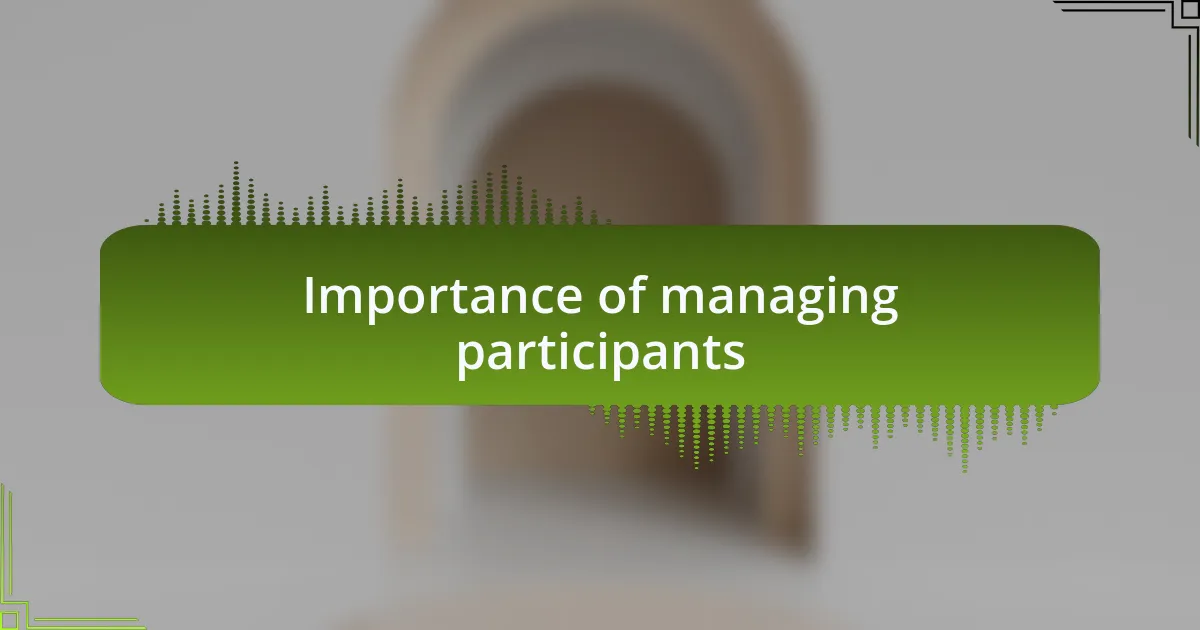
Importance of managing participants
Managing participants at any event is essential for a smooth and productive experience. I recall a time when I witnessed a heated debate during a panel discussion. The moderator’s ability to address the diverging opinions while keeping the conversation respectful made all the difference. It highlighted how effective management can turn tense moments into opportunities for enlightening dialogue.
Another experience comes to mind where I had to navigate a disruptive participant who monopolized the floor. Initially, it felt overwhelming, but by setting clear guidelines for discussion, I transformed the atmosphere entirely. This taught me that when participants know their voices are heard and valued, the overall mood shifts, fostering collaboration and engagement.
Consider the impact of managing difficult participants on the overall success of an expo. Attendees come with expectations, hopes, and sometimes frustrations, and it’s our responsibility to create a space where those needs are addressed. By doing so, we’re not just managing behavior; we’re cultivating a community where ideas can flourish and every voice has the chance to contribute meaningfully.
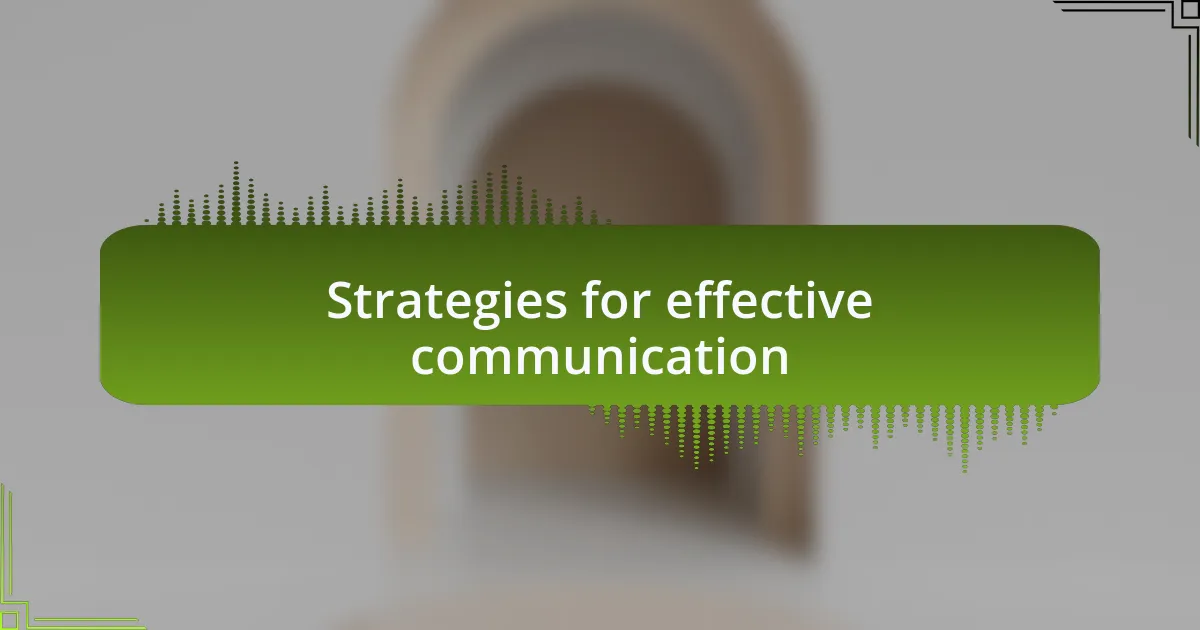
Strategies for effective communication
Effective communication is about more than just words; it’s about connection. I remember a particularly challenging session where emotions ran high. By actively listening to the concerns of the participants, I was able to empathize with their frustrations and create an environment where they felt understood. This validation often paves the way for more constructive dialogue—don’t you think that people are more open to discuss their ideas when they feel heard and valued?
Using open-ended questions can also shift the dynamic dramatically. In another instance, I was faced with a participant who resisted collaboration. Instead of confronting him directly, I asked what solutions he envisioned for our challenge. This not only redirected his energy but also encouraged others to share their thoughts. It opened a door for collaboration that I wasn’t sure would ever budge.
Moreover, maintaining a calm demeanor is crucial. I once found myself in an unexpectedly tense situation during a Q&A session; the trick was to stay cool and composed. By modeling this behavior, I noticed that participants gradually mirrored my approach. It’s fascinating how a little emotional regulation can inspire a ripple effect of respect and patience. Have you ever considered how much your own behavior influences the tone of a conversation?
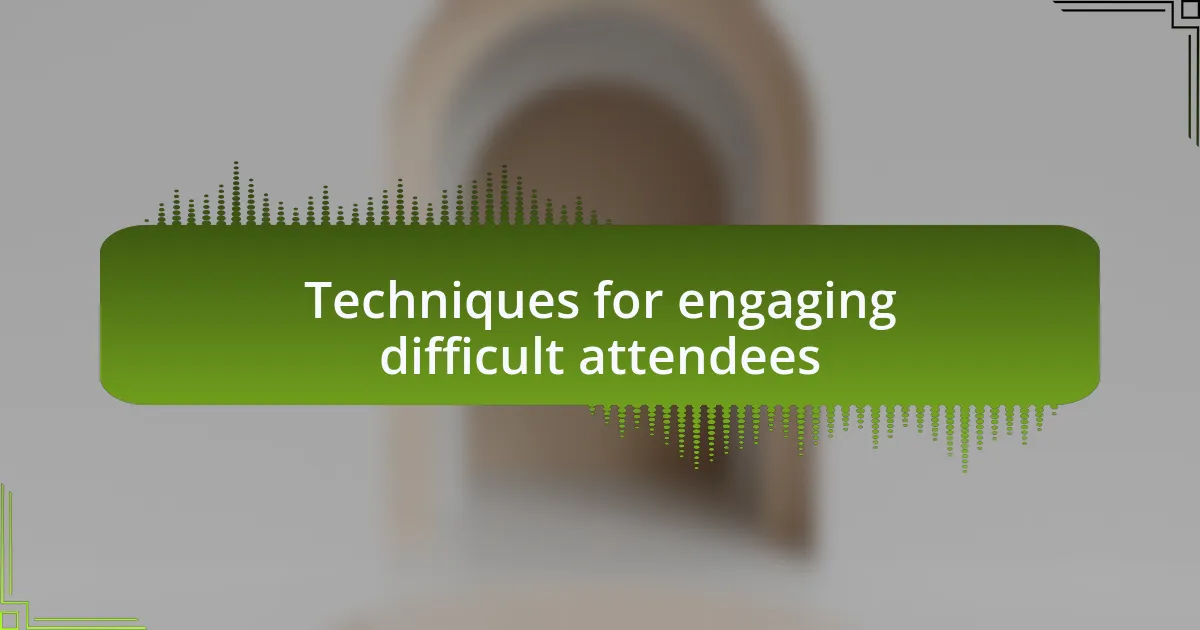
Techniques for engaging difficult attendees
Engaging difficult attendees requires a blend of curiosity and patience. I often found that blending humor into a tense situation can lighten the mood. There was a time when a particularly disgruntled participant made a sarcastic remark during my presentation. Instead of doubling down on my message, I laughed softly and responded with a lighthearted comment. This shifted the atmosphere significantly, and I noticed others relaxing and even smiling. Isn’t it interesting how humor can bridge gaps that straightforward communication sometimes struggles to cross?
Another technique I’ve discovered is the power of acknowledgment. During a workshop, I noticed one attendee who continually interrupted others. Instead of dismissing his outbursts, I paused and acknowledged his points directly. I said, “I appreciate your passion; let’s make sure we give everyone a chance to share.” That simple validation reduced the interruptions, creating a more collaborative environment. Have you ever noticed how acknowledging someone’s feelings can transform the conversation?
Lastly, involving attendees in decision-making can be a game-changer. I once faced a group resistant to a new format I wanted to implement. Rather than imposing it on them, I facilitated a brainstorming session where everyone could propose alternatives. By doing this, I empowered participants and turned their resistance into active involvement. It was rewarding to see how ownership can drastically shift attitudes. Have you ever tried inviting feedback to embrace the ideas of those who might be hesitant?
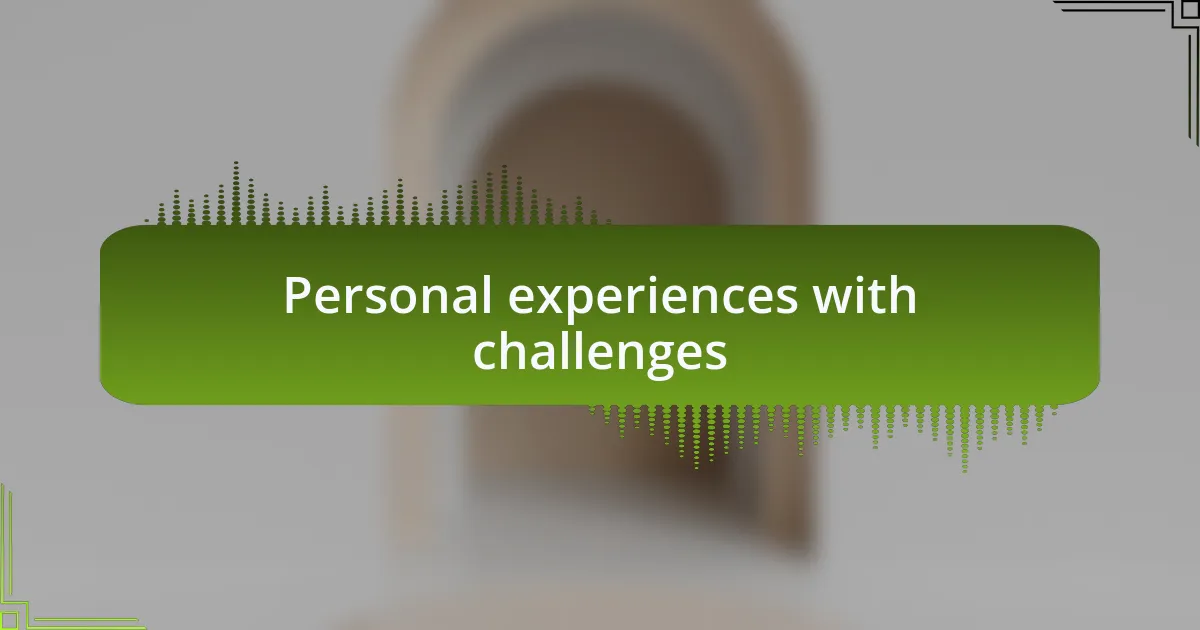
Personal experiences with challenges
Navigating challenges with difficult participants has often pushed me to my limits. There was an occasion when I encountered a participant who seemed openly skeptical of everything I said. Instead of taking it personally, I decided to invite him into the discussion. I asked, “What specifically do you think we could do differently?” His response not only opened a gateway for dialogue but also diffused the tension and fostered a sense of team spirit.
Another memorable experience involved a group that was resistant to engage in activities. I vividly remember one attendee folding her arms and glaring at me as I introduced a participatory exercise. Recognizing her discomfort, I addressed her directly, saying, “I can see this isn’t your favorite idea. What if we tweak it to make it more appealing?” This simple acknowledgment allowed her to share her thoughts, leading to modifications that delighted the entire group. Have you ever felt the power of simply validating someone’s hesitation?
A particularly challenging moment happened during a high-stakes workshop when an individual began dominating the conversation. My approach was to draw on my own experiences and say, “I once faced a similar situation when I felt unheard. Let’s ensure everyone’s voice is amplified today.” This admission not only humanized me but also encouraged others to chime in, creating a more balanced and inclusive dialogue. Isn’t it fascinating how sharing your own vulnerabilities can invite others to open up?
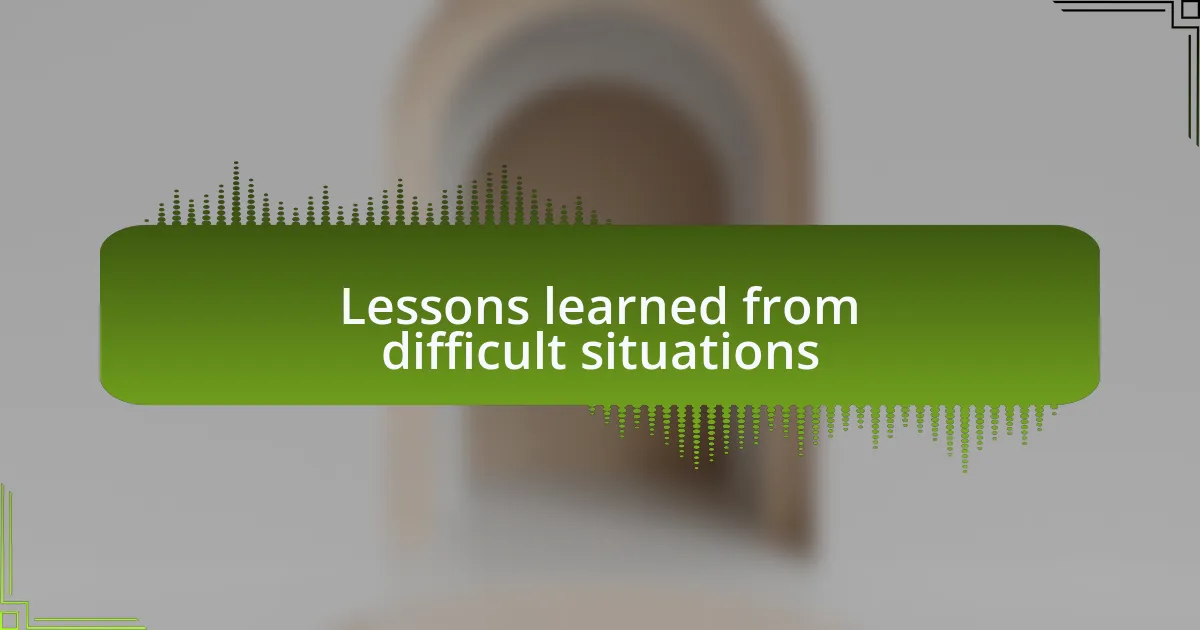
Lessons learned from difficult situations
During one particularly tense session, I found myself dealing with a participant who challenged every point I made. It was frustrating, but I remembered that everyone has their reasons for their reactions—perhaps they were anxious about the topic. I took a deep breath and encouraged him to share his perspective candidly. The discussion that followed was transformative; it taught me that sometimes, allowing space for dissent opens the door to valuable insights.
I once faced a situation in a workshop where tensions rose between participants. One group felt unacknowledged, and their body language screamed frustration. Instead of pushing forward with my agenda, I paused and facilitated a moment for them to express their concerns. Listening intently changed the atmosphere entirely and highlighted the importance of empathy in conflict resolution. Reflecting on this, I often wonder: when was the last time I made space for someone’s feelings in a challenging moment?
Engaging with reluctant participants has shown me the depth of teaching and learning. I recall a time when an attendee’s disinterest was palpable. Rather than ignoring it, I asked, “What would make this more engaging for you?” The conversation that ensued not only improved the session but also reinforced that my role isn’t just to instruct but to create an environment where everyone feels valued. It’s a powerful reminder that fostering an inclusive atmosphere often stems from addressing discomfort before it becomes a barrier.
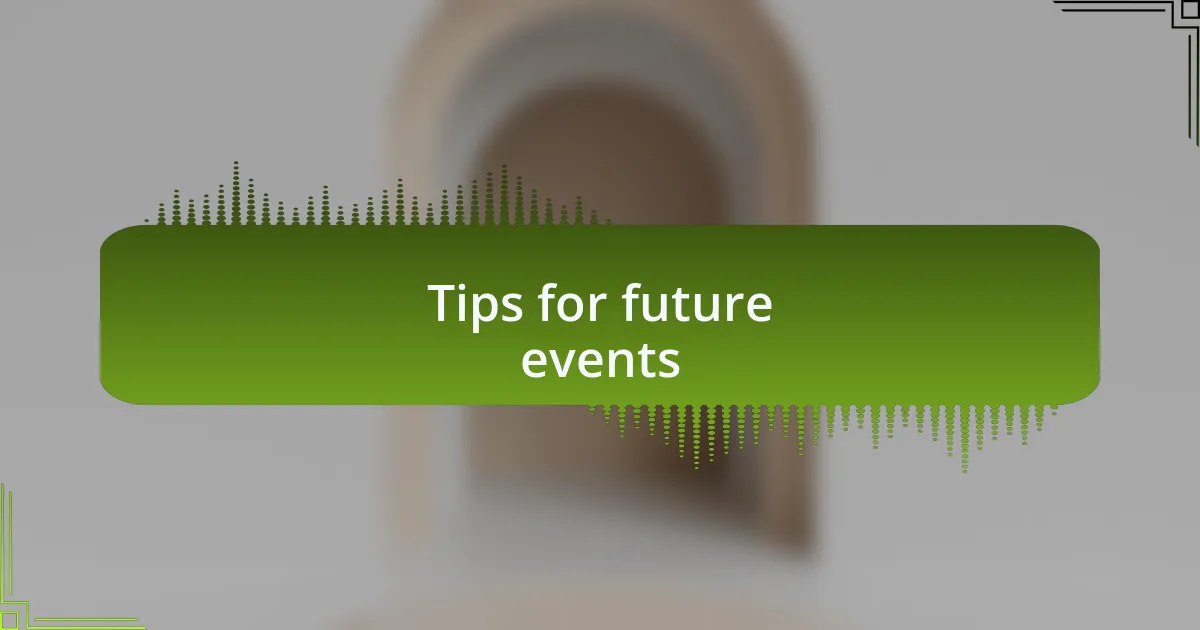
Tips for future events
When planning future events, one key takeaway is to establish clear communication channels from the outset. I recall a workshop where misinformation circulated, leading to confusion among participants. By clearly outlining expectations and using various platforms for updates, I found that it significantly reduced misunderstandings and created a more cohesive experience. Have you ever felt lost in an event due to a lack of communication? It’s an area where a little effort can go a long way.
Another essential tip is to foster relationships before the event begins. I’ve noticed that when I take the time to connect with attendees through pre-event engagement, they are more likely to share their thoughts openly once the event starts. In one case, a simple email introducing myself and inviting feedback transformed a group of strangers into a supportive community. Isn’t it intriguing how a little personal touch can change the dynamics so drastically?
Lastly, utilize feedback forms not just as a post-event formality, but as a tool for continuous improvement. I remember one event where I introduced a brief live poll mid-session to gauge participant engagement. The insights gained in real time allowed me to adjust my approach, ensuring everyone got the most out of the experience. Have you tried this approach? It’s impressive how real-time feedback can enhance interactivity and make everyone feel heard.